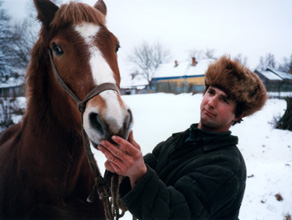Alexei and the Spring
Motohashi Seiichi
Japan 2002

|
Delphi |
Weltvertrieb: Sosna Film, 164-0003 Nakano-ku,
Higashina Kano, 4-4-1-7F, Tokyo
Tel.: (81-3) 3227 1870
Fax: (81-3) 3227 1406
e-mail: polepole@mac.email.ne.jp
Kamera: Masafumi Ichinose
Musik: Sakamoto Ryuichi
Ton: Nagai Shigeo
Schnitt: Muramoto Masaru
Format: 35 mm, 1:1.85, Farbe
Länge: 104 Minuten, 24 Bilder/Sek.
Sprache: russisch, weißrussisch
Budische, ein kleines Dorf in der Republik Weißrussland. Durch
den Reaktorunfall in Tschernobyl wurde es radioaktiv verstrahlt.
Die meisten Bewohner haben es verlassen. Nur fünfundfünfzig
ältere Menschen und ein junger Mann namens Alexej sind geblieben,
weil das Dorf ihre Heimat ist, und weil es dort eine hundert
Jahre alte Quelle gibt. Ihr kristallklares Wasser, das der
Verseuchung nach dem nuklearen Unfall entging, löscht den
Durst der Menschen und ist eine wichtige Grundlage für das
Leben im Dorf, für viele sogar so etwas wie der Mittelpunkt
ihres Lebens. Hier treffen sie sich mit den anderen, erzählen sich
ihre Geschichten, halten Waschtag ab. Die Quelle spielt aber
auch die Rolle der Dorfkirche. Neben ihr sind selbst gemachte
Kreuze und Ikonen als Opfergaben aufgestellt, denn die
Dorfbewohner glauben, dass Gott in der Nähe des Wassers lebt.
Deshalb hält hier ein Priester im Rhythmus der Jahreszeiten
Gottesdienste ab.
Jeden Sommer müssen die Dorfbewohner den alten Holzrahmen
um die Quelle herum ausbessern – ein langwieriger Vorgang,
denn dazu müssen im Wald Bäume gefällt werden und zwar
ohne
die Hilfe moderner Maschinen, denn die Siebzigjährigen, die
dies durchführen, sind gewohnt, nach den ihnen überlieferten,
handwerklichen Methoden die Balken zu bearbeiten...
Motohashi Seiichi, geb. 1940 in Tokio. Studium an der Hochschule für Fotografie in Tokio. Fotograf und Filmemacher. Fotobücher u.a. Roujin to umi (An Old Man and the Sea), Mugen Houyou (Tschernobyl). Bisher zwei Filme: Nadya’s Village (Forum 1998), Alexei and the Spring (2002).